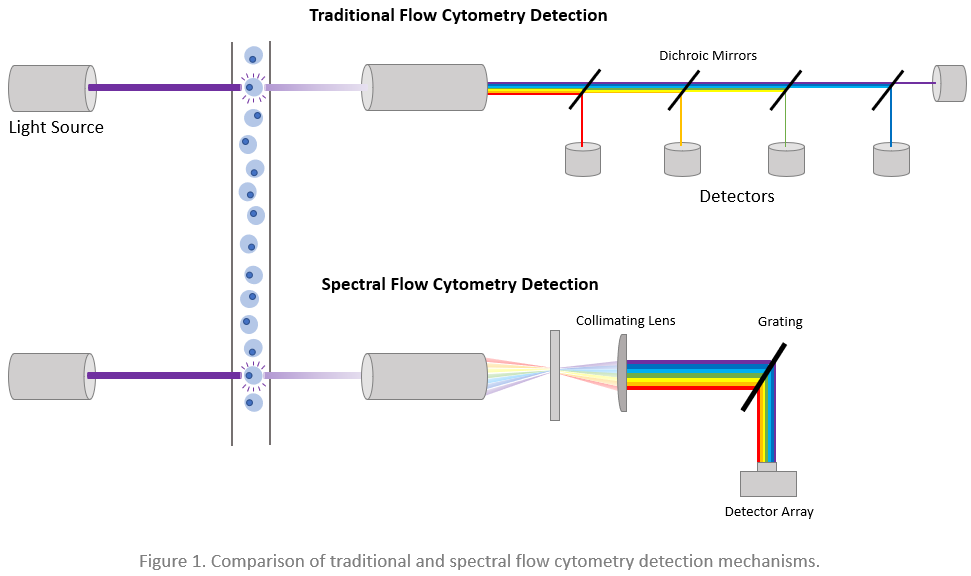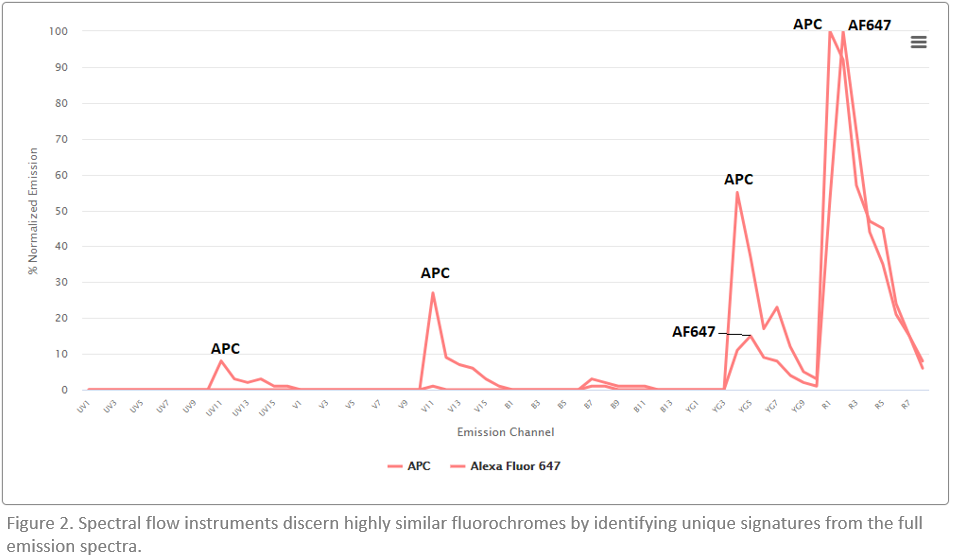Maximize the benefits of spectral flow cytometry by using the right fluorochromes
Spectral flow cytometry enables researchers to conduct larger and more comprehensive flow cytometry experiments than ever before, in some cases with over 40 different fluorochromes in a single experiment. This is achieved using panels that combine existing fluorochromes with those developed specifically for spectral analyzers, but it is critical to remember that many of the same panel design considerations relevant to traditional flow cytometry still apply. Here, we explain some key differences between traditional and spectral flow cytometry and highlight the importance of choosing the right fluorochromes to take full advantage of your spectral analyzer’s capabilities.
Spectral analyzers are a next-generation flow cytometry technology
Spectral analyzers evolved from researchers’ needs to maximize the amount of information obtained from often limited sample material. Unlike traditional flow cytometers, which use dichroic mirrors and bandpass filters to detect discrete ranges of wavelengths on individual photomultiplier tubes (PMTs), spectral analyzers rely on more advanced optics to capture the entire emission spectrum of each fluorochrome across an array of detectors; distinct fluorochromes are then identified using specialized software to unmix the emission profiles. By removing many of the panel design constraints inherent to traditional flow cytometry, spectral analyzers allow fluorochromes that would normally be incompatible – for example, APC and Alexa Fluor 647 – to be used together in the same experiment. The first commercially available spectral analyzer, the SP6800, was released by Sony in 2012. Using a series of prisms to disperse emitted light across a 32 channel PMT array, this collects wavelengths from 420 – 800 nm and has been widely cited in literature. More recently, the SP6800 has been complemented by the ID7000™ that instead uses a grating for light dispersion and collects wavelengths from 360 – 920 nm; this can be configured with up to 7 lasers and 186 detectors for experiments comprising as many as 44 colors – more than any other spectral analyzer at the present time. Cytek® is another major player in the field of spectral flow cytometry instrumentation, having released its Aurora back in 2017. Rather than using prisms or a grating, the Cytek® Aurora relies on a proprietary technology known as coarse wavelength division multiplexing (CWDM) to disperse light, integrating this with avalanche photodiode (APD) detection to capture wavelengths from 365 – 829 nm. The Cytek® Aurora has more recently been joined by a simpler, more budget friendly model known as the Cytek® Northern Lights that can easily be upgraded from a single laser, 9-color base unit to a system comprising three lasers and 24 colors.
Spectral flow cytometry offers many advantages
A main advantage of spectral flow cytometry is that it allows fluorochromes with similar emission maxima to be combined in the same experiment. This is because detecting the full emission spectrum of each fluorochrome rather than just the emission peak allows distinct off-peak signatures to be used for distinguishing different fluorochromes from one another. In practice, this means more readouts per laser, translating to deeper sample analysis and greater flexibility in panel design. A further important benefit of spectral flow cytometry is its superior sensitivity compared to traditional methods. Not only can spectral analyzers enhance dim signals but they can also more accurately distinguish true signal from sample autofluorescence, making them an ideal solution for applications that are not currently possible using conventional instruments. For example, spectral analyzers can be used to separate labels with narrow emission spectra, such as quantum dots or Raman scattering labels, that are used for many different types of research.
Specialized fluorochromes are available for spectral analyzers
A broad range of fluorochromes has been developed to enhance spectral analyzer capabilities. While these are typically designed to be compatible with both existing fluorochromes and other dyes within the same spectral product line, most manufacturers provide similarity matrices enabling researchers to determine their suitability for use with other commercially available fluorochromes. By extending the scope of current fluorochromes, these newer products greatly simplify the construction of large panels. Popular fluorochromes for spectral flow cytometry include Bio-Rad’s StarBright dyes (a range of proprietary, extremely bright fluorescent nanoparticles with exacting excitation and emission characteristics); NovaFluor™ fluorescent labels from Phitonex™ (recently acquired by Thermo Fisher Scientific – NovaFluor™ dyes are available as different brightness levels so that researchers can choose between a bright version or a dim version of the same dye depending on antigen density); Biotium’s CF® dyes (benefiting from distinct far-red and longer emission spectra); and BioLegend’s Fire™ and Spark dyes (created to fill gaps between existing fluorochromes).
Fluorochrome selection for spectral flow cytometry
Although panel design is more straightforward for spectral flow cytometry than for traditional flow, the same fundamental principles still apply. For optimal results, brighter fluorochromes should be paired with less abundant targets (and vice versa) and panels should always be constructed to ensure as little spectral overlap as possible. Manufacturers’ websites can be useful sources of information when less familiar fluorochromes – such as those designed specifically for spectral analyzers – will be used. For example, Biotium notes that while CF®660C and CF®660R are distinct when measured by the Cytek™ Aurora, pairing such similar dyes is not generally recommended for spectral flow cytometry. And, of course, you can always count on us to help you navigate the process of panel design! FluoroFinder’s Spectra Viewer lets you quickly compare over 900 fluorochromes from all suppliers in one intuitive platform, including fluorochromes designed specifically for spectral flow cytometry, while our Panel Builder enables you to optimize your multi-color flow or spectral cytometry experiments with the latest fluorochrome and antibody offerings across >60 suppliers. So what are you waiting for? Gain even deeper insights from your samples by using our resources to support your research! Sign up for our eNewsletter to receive the latest flow cytometry updates. Do you have another feature you would like to see added to FluoroFinder? Contact us to offer suggestions.







